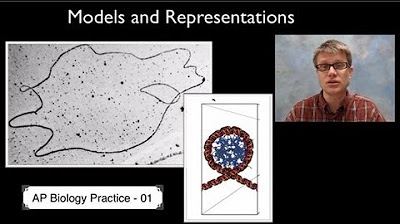3.1/3.2 Enzyme Structure + Catalysis - AP Biology
Summary
TLDRIn this AP Biology lesson, Mr. Poser explores cellular energetics, focusing on the role of enzymes in metabolism. He explains how enzymes act as biological catalysts to speed up chemical reactions by lowering activation energy. The video covers key metabolic pathways, including catabolic and anabolic processes, and illustrates how enzymes help convert complex molecules into simpler ones, such as the breakdown of lactose. The lesson highlights the specificity of enzymes and their vital role in processes like glycolysis and cellular respiration, essential for energy production in living organisms.
Takeaways
- 😀 Metabolism refers to all the chemical reactions in an organism, essential for life and energy production.
- 😀 Organisms need a constant input of energy and macromolecules for growth, energy extraction, and to remove waste products.
- 😀 Metabolic pathways are sequences of reactions where molecules are altered step-by-step, resulting in products.
- 😀 Metabolic pathways are divided into two types: **catabolic pathways** (breaking down molecules) and **anabolic pathways** (building complex molecules).
- 😀 Catabolic pathways, like digestion, break down large molecules into smaller units, releasing energy.
- 😀 Anabolic pathways use smaller components to build larger molecules, such as proteins or polysaccharides.
- 😀 Enzymes are biological catalysts that speed up chemical reactions by lowering the activation energy required for the reaction to proceed.
- 😀 Activation energy is the initial energy needed to start a chemical reaction, comparable to pushing a ball to the top of a hill.
- 😀 Enzymes work by lowering the activation energy, enabling reactions to happen more efficiently and quickly, which is crucial for life.
- 😀 Enzymes are highly specific and catalyze only one type of reaction, such as lactase breaking down lactose into glucose and galactose.
- 😀 The enzyme-substrate complex forms when the enzyme binds to the substrate at its active site, facilitating the reaction and converting substrates into products.
Q & A
What is the focus of the unit on cellular energetics in AP Biology?
-The unit on cellular energetics focuses on understanding how cells obtain and use energy. It covers enzymes, metabolism, and essential processes like photosynthesis and cellular respiration.
What is metabolism, and how is it categorized?
-Metabolism refers to the total chemical reactions within an organism. It is categorized into catabolic pathways, which break down larger molecules into smaller ones, and anabolic pathways, which build larger molecules from smaller components.
What is the role of enzymes in metabolic reactions?
-Enzymes act as biological catalysts that speed up metabolic reactions by lowering the activation energy required for the reaction to occur, making them essential for life processes.
What would happen if enzymes did not exist in living organisms?
-Without enzymes, metabolic reactions would occur too slowly to sustain life, meaning cells could not extract energy or break down and build molecules efficiently.
What is activation energy, and how do enzymes affect it?
-Activation energy is the energy required to start a chemical reaction. Enzymes lower the activation energy, making it easier for the reaction to occur and speeding up the process.
What is the difference between catabolic and anabolic pathways?
-Catabolic pathways involve breaking down larger molecules into smaller components, releasing energy. Anabolic pathways involve building complex molecules from simpler ones, which requires energy input.
Can enzymes catalyze more than one type of reaction?
-No, enzymes are highly specific and typically catalyze only one type of reaction, acting on a specific substrate.
What is an enzyme-substrate complex, and how does it work?
-An enzyme-substrate complex forms when a substrate binds to the enzyme's active site. This binding allows the enzyme to lower the activation energy, facilitating the conversion of the substrate into products.
What happens to the enzyme after it catalyzes a reaction?
-After catalyzing a reaction, the enzyme releases the products and changes shape slightly to allow the active site to become available for the next substrate, repeating the process.
How does the concept of induced fit relate to enzyme function?
-Induced fit refers to the change in enzyme shape that occurs when the substrate binds to the active site. This shape change helps the enzyme hold the substrate more tightly, ensuring the reaction occurs efficiently.
Outlines

This section is available to paid users only. Please upgrade to access this part.
Upgrade NowMindmap

This section is available to paid users only. Please upgrade to access this part.
Upgrade NowKeywords

This section is available to paid users only. Please upgrade to access this part.
Upgrade NowHighlights

This section is available to paid users only. Please upgrade to access this part.
Upgrade NowTranscripts

This section is available to paid users only. Please upgrade to access this part.
Upgrade NowBrowse More Related Video

2.10/2.11 - Compartmentalization/Origins of Compartmentalization - AP Biology

2.6 Membrane Transport - AP Biology

AP Biology Practice 2 - Using Mathematics Appropriately

AP Biology Science Practice 1: Models and Representations

2.5 Membrane Permeability - AP Biology

2.7 Facilitated Diffusion - AP Biology
5.0 / 5 (0 votes)